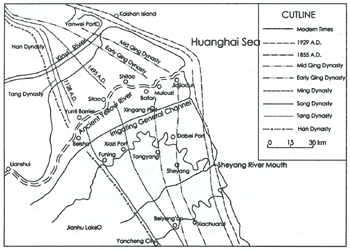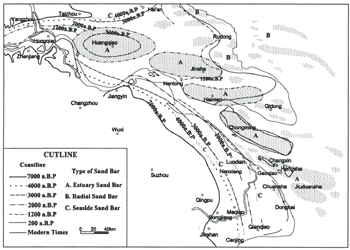|
THE GREAT IMPACT OF HUMAN ACTION ON THE DEVELOPMENT PROCESS OF COASTAL LANDFORM
Da-yuan Yang, Xu-sheng Li, Xiao-wei Jiang, Jiang-hua Wu
Department of Geography, Nanjing University
Nanjing, CHINA
yangdy@nju.edu.cn
ABSTRACT
Taking the Yangtze River delta and the old Yellow River delta of China as examples, this paper analyzes the impact of human action (building dykes along the river) on the delta coastal development. Constructing dykes along the rivers relieved flood overflowing and silt depositing on the flood plains along the valley. But, it not only increased the silt depositing in the bed of the rivers, but also increased the flood and sediment discharge into the sea, that speeded up the river delta development. Therefore, construction of artificial dykes played an important role on the coastline development.
INTRODUCTION
The human impact on coastal development has been a topical subject in academic circles for over years (Bird, 1976). With regard to the change of advance speed of the Yangtze Delta coastline, Tan Qixiang (1970) put forward that it related to northern war of China, population migration southward, sloping fields reclamation, and soil erosion increase. Actually, human impact on coastal landform process is more complicated than that was studied. Besides direct impact, long-distance human activity and lag influence should be considered. For example, annual sediment discharge of the Yellow River is considered as 16 × 108 t/a, and the Yangtze River is about 4.71 × 108 t/a. Actually, the sediment discharge of the Yellow River and the Yangtze River is changeable. The human activity exerts impact on annual sediment discharge in multiple ways, while the annual sediment discharge plays a decisive role on delta development.
Coastline change of the old Yellow River delta
From A.D. 1128 to 1855, the Yellow River had been entering the Yellow Sea through middle area of Jiangsu Province. During this time, the river from near Kaifeng city to the mouth is called the old course of the Huanghe River. One of delta plains was formed out of the ancient mouth there (Fig.1). The delta coastline had advanced toward the sea with the average rate from 7 m/a to 24 m/a before A.D.1496, but it increased to 91 m/a on average from 1495 to 1855. The mentioned change was not related to the sea level changes in that period, and may be mainly related to the sediment discharge of the lower reaches of the ancient Yellow River (Fig.2, Yang, 1991). Before A.D. 1495, the inundation of the ancient Yellow River submerged the ancient Xuzhou city, Kaifeng city, and led to the construction of the ancient flood plain and the delta in the Weishanhu Lake (Zhang Zulu, 2002). The ancient Kaifeng City in Song Dynasty was inundated to a depth of about 8m by sediment of the Yellow River. But when the artificial dyke was built along the ancient Yellow River in A.D. 1496, the riverbed aggravated rapidly by appreciable sediment trapping behind the dams and formed shoals along the banks. The surface of the shoals was higher about 8-9 m than that of the plain beside the dykes. In the same time, the flood and sediment discharge into the sea increased, which resulted in the rapid growth in area of the ancient Yellow delta. The coastline advanced approximate 33 km seaward during 360 years before A.D. 1855, when the Yellow River returned back into the Bohai Sea.
| (Enlarge: 56KB) |
 |
Figure 1. The development of the old Yellow River delta
In the last 50 years, there has been no great inundation occurred in the lower course of the Yellow River. Based on the comparison among maps from different ages simultaneously, from 1953 to 1982, the terrestrial land in the yellow River delta increased about 1100 km2. Up until 1994, another 1100 km2 was added to the delta due to the same reason (Chen Chao, 2002).
Figure 2. The main influencing factors on the development of the old Yellow
River
Growing of the Yangtze River delta
The middle and lower reaches of the Yangtze River, which extend from Yichang to the river mouth, are about 1,800 km long. Collectively, a length of 3,600 km of dykes has been built along the river since A.D. 345. (Table 1)
Table 1. Some long dykes along the middle-lower reaches of the Yangtze River
| Dyke |
Length (km) |
Construction time |
| Jingjiang Dyke |
182.31 |
Originally constructed in AD 345 System formed in AD 1542 |
| Honghu Dyke |
130 |
|
| Wuhan Dyke |
178.53 |
Originally constructed in AD 1635 System formed in Qing Dynasty |
| Huangguang Dyke |
87.3 |
Originally constructed in AD 1404 System formed in AD 1932 |
| Jiujiang Dyke |
60 |
Originally constructed in AD 1954 |
| Gandong Dyke |
141.46 |
Originally constructed in Song Dynasty (A.D.960-1127) |
| Tongma Dyke |
130 |
Originally constructed in Jin |
| |
|
Dynasty (A.D.265-420) |
| Jiangsu Dyke |
|
|
(left bank)
(right bank) |
498.5
529.7 |
Originally constructed in Song Dynasty System formed in last century |
|
Most dykes were originally constructed in the Song dynasty, and the river-dyke system was formed in the Ming-Qing Dynasties. Because of the dyke-system getting more and more mature, more and more sediment discharged to the river mouth. In the middle-late of last century, the sediment discharge reached to 4.71 × 108 t/a according to the data from Dating monitoring station, which is located in the lower reaches of Yangtze River. The development of the Yangtze River delta has also speeded up since the Song Dynasty (Xu et al., 1987). (Fig.3)
| (Enlarge: 78KB) |
 |
Figure 3. The development of the Yangtze River delta
In the last 50 years, there have been no great inundations in the Yangtze River and the great amount of sediment poured into the mouth reaches of the Yangtze River. It caused that the Zhengrunzhou flood plain near Zhenjiang city deposited about 6 × 108 t sediment based on the analyses of isobath lapse. The area of the Chongming Island of Shanghai city was increased rapidly from 600km2 to 1200 km2, and formed Changxing Island, Hengsha Island and Jiuduansha Island one by one.
CONCLUSION AND DISCUSSION
Based on the historical records reviewed here, we discovered that delta building by the rivers accelerated following completion of the artificial dyke system. Taking the Yangtze River delta and the old Yellow River delta as examples, flood overflowing from the channel supplied sediment to build wide flood plains along the rivers before the construction of artificial river-dyke. However, after the dyke construction, river sediments no longer build the flood plain but are deposited in the riverbed to build shoals and transferred downstream to build the delta plain at the mouth of the river. Therefore, the human activities have become the dominant agent for development of some delta plains and exerted important impact on the coastal landform development.
ACKNOWLEDGEMENT
This paper was supported by the National Nature Science Foundation of China (40272126).
REFERENCES
Bird, E.C.F. 1976. Shoreline changes during the past century. Proceedings of the 23rd International Geographical Congress, Moscow. Elmsford, N.Y. Pergamon. 54 pp.
Chen, Chao. 2002., Striking terraqueous change of the Chinese territory. Xinhua Daily. [In Chinese] Jan. 30, 2002, p.C2.
Tan, Qixiang. 1970. Sea-land change and exploitation process of the coast of Shanghai city. Archaeology. [In Chinese] 1.28-35.
Xu, Shiyuan, Wang Jingtai, Li Ping, 1987, On the Developmental Periods of the Yangtze River Delta. In: Yan Qinshang. Xu Shiyuan eds. Recent Yangtze Delta Deposits. Shanghai, East China Normal University Press. [In Chinese] 264-277.
Yang, Dayuan. 1991. Sea level change of the middle Jiangsu province since 2000a B.P.. Chinese Science Bulletin. [In Chinese] 20:1574-1577.
|